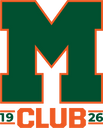Facilities
The Miami Orange Bowl
 |
Orange Bowl Information
Fan Plan in PDF Format ![]() Photo GalleryOrange Bowl Aerial PhotosOrange Bowl Seating ChartParking InformationParking MapDirectionsRules
Photo GalleryOrange Bowl Aerial PhotosOrange Bowl Seating ChartParking InformationParking MapDirectionsRules
Orange Bowl Nostalgia: There’s No Place Like Home
Dedicated: December 10, 1937
Capacity: 72,319
Surface: Prescription Athletic Turf
Asst. Stadium Manager: Ileana Gomez
Phone Number: (305) 643-7100
Address:
- 1501 N.W. 3rd St., Gate 14
Miami, FL 33125
or P.O. Box 350748
Miami, FL 33135
Field: Runs East (open end) to West
History
The City of Miami, with a then population of 150,000, entered into a contract on July 30, 1936 for the building of a football stadium. The stadium was completed in mid-1937 at a total cost of $340,000. The stadium initially was named after one of Miami’s oldest pioneers, Roddy Burdine, before becoming Orange Bowl Stadium in 1959.
Dedication
December 10, 1937, during the Miami-Georgia football game. The Hurricanes lost, 26-0. The seating capacity was 22,000.
Surface
Prescription Athletic Turf (Natural Grass) Transition from artificial was made in 1977.
Lighting
Regular metal halide.
Press Box
The fifth floor level can accommodate 92 writers plus the scoreboard, public address and statistics crews. Live television and radio broadcast crews are assigned to the third floor. Television and photo news crews have access to the roof of the press box, which is also used for overflow media seating. The fourth and sixth floors are VIP seating and hospitality areas. Use the South Central Plaza, for press will call and entrance to the press box.
Expansion
The original stadium, with a seating capacity of 23,330, soon outgrew itself and in 1944 stands were added to the endzones bring capacity to 35,030. In 1947 a second expansion added an additional 24,548 seats. Following expansions in 1950 (4,974 seats), ’53 (2,577) and ’55 (9,157) double-decking and construction of the wings were completed. The west end zone was filled in and both the upper and lower deck seats were added, raising capacity to 80,010. The east end zone seats were removed in 1977, reducing the capacity to 75,500. Expansion of the VIP seating and the addition of contour seats in the early 1990s reduced the capacity to 74,712. In 1994, completion of construction designed to improve handicap seating further reduced capacity. Renovations in 1996 to accommodate Olympic soccer reduced capacity to 72,319.
Home to Big Games
The Orange Bowl has hosted five Super Bowls, the most recent on January 21, 1979, when the Pittsburgh Steelers defeated the Dallas Cowboys, 35-31, in Super Bowl XIII. Since 1970, when the collegiate national champion was first selected after the completion of the bowl games, the Orange Bowl Classic has hosted 11 games that decided the national title. Until the 1996 season when the OBC moved to Pro Player Stadium, Orange Bowl Stadium hosted eight of the last 13 national championship games, including University of Miami titles in 1983, 1987,and 1991.
Olympic Soccer
From July 20-28, 1996 the Orange Bowl served as a site for Olympic soccer.
Largest All-Time Home Crowd
The largest crowd to witness any event in the Orange Bowl was in 1995 when 81,753 watched Nebraska defeat Miami, 24-17, in the Orange Bowl Classic. Temporary bleachers were added to the east end zone to accommodate the overflow. The largest crowdfor a professional football game in the Orange Bowl was 80,187 on January 18,1976, to see the Pittsburgh Steelersdefeat the Dallas Cowboys, 21-17, in Super Bowl X.
Directions To The Orange Bowl
FROM MIAMI AIRPORT – Take Exit marked Coral Gables/LeJeune Rd.Exit onto LeJeune and just past the overpass turn right to enter onto Highway836 East. Immediately after the toll gate (25 cents), take the first exit,NW 17th Ave., South. Turn left on NW 3rd St. for Press Parking, which isonly accessible with a parking pass.
FROM DOWNTOWN & I-95 – Take I-95 to 836 West. Take the firstexit, NW 12th Ave. Turn left and go across the bridge. Turn right ontoNW 7th, 6th, 5th, 4th, or 3rd streets to the Orange Bowl (NW 3rd St. willlead to Press Parking, which is only accessible with a parking pass.)






